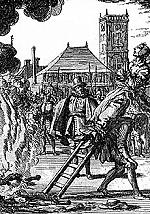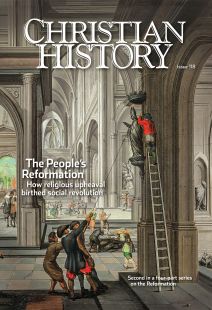Tearing down the images
![]()
I approached the task of destroying images by first tearing them out of the heart through God’s Word and making them worthless and despised.” So declared Martin Luther about the use of images in church in one of his early books titled Against the Heavenly Prophets.
Around the same time, Huldrych Zwingli wrote a letter to a friend named Urbanus opining, “Let us not be prematurely troubled as to the abolition of the mass or the casting out of the images, but let us labor to restore to their Creator the hearts that are given over to this world. The mass has fallen already; the images will, I think, disappear of their own motion. For we shall banish in vain one or the other unless public piety ratify the decree.”
Unfortunately not everyone felt the same way, and trouble brewed in Switzerland. One night in 1523 shoemaker Klaus Hottinger (d. 1524) collected a group of friends. They went out into a village near Zurich where a rather large crucifix was erected in the town square and destroyed it, pulling it down and disposing of its parts in a fire. This act caused a serious scandal, and the perpetrators were hauled before the judges and condemned for their unwise behavior.
Destroying the idols
But the floodgates were opened. Throughout the Canton of Zurich in the early 1520s, a series of raids on churches resulted in the destruction of countless works of art. Walls were whitewashed, images were removed and destroyed, and violent acts were perpetrated against priceless works of art, or as their destroyers preferred to call them, “godless idols.”
Zwingli above all craved order and proper behavior, and he eventually won the day, but not until the damage had been largely done. Authorities were able to calm the crowds; the remainder of the churches were purged of images, paintings, and decorations without violence. Patrons who had donated art reclaimed it, and those works that were not destroyed were sold and the proceeds used for the relief of the poor, as Zwingli repeatedly urged: “Human reason says: ‘Set up images to honor God and the saints.’ Religion cries out against that: ‘No. No. Bestow upon the poor that which you wish to use to honor God.’”
Order Christian History #118: The People’s Reformation in print.
Subscribe now to get future print issues in your mailbox (donation requested but not required).
For Luther and Zwingli (and later Calvin), art as art was a gift of God. Art misused in the construction of idols was a distortion of that good gift and a sin.
Zwingli believed that the commandment against the making of images made any religious art used in worship into an idol. In Answer to Valentin Compar, he wrote, “The believers, or those who are trusting, go to God alone; but the unbelievers go to the created.” And he remarked to Emperor Charles V in a confession delivered to the emperor in Augsburg, “Images . . . which are misused for worship, . . . [are] diametrically opposed to the Word of God. But those which do not serve for worship and in whose cases there exists no danger of future worship, I am so far from condemning that I acknowledge both painting and statuary as God’s gifts.”
This article is from Christian History magazine #118 The People’s Reformation. Read it in context here!
Christian History’s 2015–2017 four-part Reformation series is available as a four-pack. This set includes issue #115 Luther Leads the Way; issue #118 The People’s Reformation; issue #120 Calvin, Councils, and Confessions; and issue#122 The Catholic Reformation. Get your set today. These also make good gifts.
By Jim West
[Christian History originally published this article in Christian History Issue #118 in 2016]
Jim West is professor of biblical studies at Quartz Hill School of Theology and lecturer in biblical and Reformation studies at Ming Hua Theological College. He blogs about Zwingli and the Reformation frequently at Zwinglius Redivivius.Next articles
A fire that spread
As soon as the Anabaptist movement began, it was persecuted
Walter Klaassen and John OyerThe accidental revolution
The English Reformation began with a king but took hold among a people
Melinda S. ZookA motley, fiery crew
Sometimes difficult, always committed, these men advanced the Reformation in Germany, Switzerland, and England
David C. Steinmetz and Edwin Woodruff TaitSupport us
Christian History Institute (CHI) is a non-profit Pennsylvania corporation founded in 1982. Your donations support the continuation of this ministry
Donate









